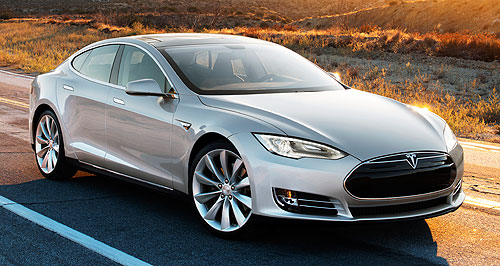News - TeslaTesla Autopilot fatality under investigationSafety first: While Model S owners have access to an Autopilot autonomous driving mode, Tesla says owners still need to pay attention to the road and be ready to take back control of the vehicle. NHTSA launches inquiry into Tesla’s self-driving technology after fatal car crash1 Jul 2016 By TUNG NGUYEN THE fatal crash of an American driver in a Tesla Model S with the Autopilot self-driving function engaged has sparked an investigation by the US National Highway Traffic Safety Administration (NHTSA) into the electric car-maker’s autonomous driving technology. The incident – the first fatality relating to an autonomous driving system – took place last month in Florida and involved the victim’s Model S sedan colliding into, and passing under, a truck trailer. In a statement released by the NHTSA, the US road safety governing body described the crash occurring “when a tractor-trailer made a left turn in front of the Tesla at an intersection on a non-controlled access highway”. Tesla, which identifies its Autopilot software as a safety system, responded in an official blog post detailing that “neither Autopilot nor the driver noticed the white side of the tractor trailer against a brightly lit sky, so the brake was not applied”. The tech start-up was also quick to point out that the Autopilot system “requires explicit acknowledgement that the system is a new technology and still in a public beta phase before it can be enabled” and that “it is important to emphasise that the NHTSA action is simply a preliminary evaluation to determine whether the system worked according to expectations”. Tesla’s Autopilot feature was first rolled out in October last year as a free over-the-air update to all existing Model S cars and is also available on all upcoming Model X SUVs, giving drivers access to a semi-autonomous mode under the right conditions. The system involves a front-facing camera to read speed signs and radar-guided cruise control to operate throttle and braking applications. Autopilot can also read line markings on roads to keep the all-electric vehicles within the lane while also changing lanes if indicated. Updates to the system are planned to introduce the ability to read traffic lights. If the system loses the required data inputs to maintain Autopilot, drivers will be alerted to retake manual control of the vehicle and Tesla explicitly states users should “always keep your hands on the wheel” and to “be prepared to take over at any time”. According to Tesla, while using Autopilot mode “you need to maintain control and responsibility for your vehicle” and that the system “is not perfect and still requires the driver to remain alert”. Even without the Autopilot system, the Model S electric sedan received a maximum five-star safety rating in Euro NCAP crash testing and holds the record for highest crash safety score logged by the NHTSA. However, the circumstances of the accident bypassed the Tesla’s extensive crash safety features with the windshield of the Model S impacting the bottom of the trailer. Tesla says it has logged almost 210 million kilometres of Autopilot driving worldwide and maintains that “the data is unequivocal that Autopilot reduces driver workload and results in a statically significant improvement in safety when compared to purely manual driving”.  Read more20th of May 2016  Powerful US lobby pushes driverless car causeUS energy security council calls for law reform to boost autonomous car sector19th of May 2016  Britain aims to become leader in driverless carsNew legislation aims to bolster UK drive to become leader in autonomous vehicles18th of May 2016  Tesla investigates damning reportUnderpaid foreign workers allegedly hired by subcontractor for Tesla paint plant11th of April 2016  It’s an urban jungle out there for driverless carsMercedes-Benz chief says city slog still a challenge for autonomous vehicles12th of February 2016  Tesla goes hands-free with Model SAutopilot feature showcased as Tesla headlines Pause Fest tech gathering |
Click to shareTesla articlesResearch Tesla Motor industry news |
















Facebook Twitter Instagram